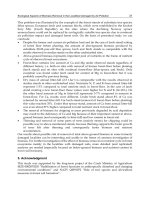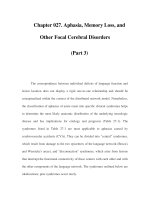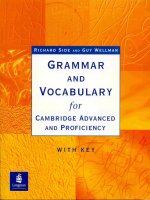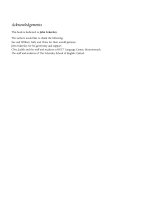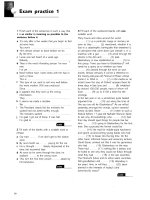Grammar and vocabulary games for children - part 3 pot
Bạn đang xem bản rút gọn của tài liệu. Xem và tải ngay bản đầy đủ của tài liệu tại đây (1.67 MB, 10 trang )
Game #23)
Parts ofspeech Bingo
Prepare a set of ttBingo'' cards for each player, using pages 53 to 59 in the
appendix. Every child should have 2 or 3 of each part of speech to play the gam e.
You m ay wish to cut the sheets up into separate cards yourself, or if you have
enough scissors, ask the children to cut their own sheets up into çtparts of speech''
squares. Now , ask the children to sort their bingo cards into neat little piles for
each pa14 of speech, so that the cards can be easily chosen during the gam e. Tell
the children that you are going to call out a w ord, and that they have to decide
(quietly to themselves, without speaking) to which part of speech the word
belongs. A s soon as they ltnow , they m ust put the correct part of speech onto the
floor in front of them . Give them five seconds to think, before calling out the
correct answ er. The children with the right answ er can keep their cards on the
floor. Those who have chosen the wrong answ er m ust rem ove them . N ow call out
the next w ord and repeat the gam e. Carry on until som eone has five bingo cards in
a row . This player should call out tûBingol'' and has won that round. Keep playing
for as long as the children are having ftm . Examples of parts of speech are shown
below .
Noun Verb Pronoun Adiective Adverb Conjunction
dog do it pretty yesterday and
girl kick she big quickly but
m ouse go him clever slowly because
school sleep we cold soon although
m other eat us happy happily until
house play them sad in unless
car work you tired up if
hen write he dangerous dangerously than
city draw they little tom orrow however
beach sw im m e sm aller out since
'Fhis gam e is a great way to practise vocab or gram m ar learnt over several lessons,
and should be played often to revise w ork, varying the vocabulary and parts of
speech as further w ork is covered.
Game 1124)
Ready, Set, Take Your Positionsl
Take the children out into the playground. Look around for a place w here they can
get under things, behin4 beside, between, amongst, on, in and over things such as
tables, benches, playground equipm ent, trees, bushes, and so on. Tell the children
that when you call out a preposition, you are going to turn your back and count to
thirty. During this tim e, the children must nm and get into the requested position,
somewhere in the playground within your view . Anyone still nm ning and not in
19
position when you t'tzrn around, after the count of thirty, scores a penalty point
.
Keep playing for as long as the children are enjoying themselves. Then see who
has the low est score. 'rhis player is the w inner.
Game #25)
4 Tr+ to Town
Talk about the different types of shops in a town, such as the chemist (pharmacist),
baker, butcher, new sagent, superm arket, greengrocer, bank and post office. Talk
about the different item s that can be bought in these shops. A lso tell the children
what services are offered in a bank or post office. N ow you are ready for the gam e.
Choose several shops and put signs up around the playing area, so that the
children know what each place represents. (See pages 60 & 61 of the appendix for
some shop signs). Then tell the children that you are going to call out an item for
them to buy. They m ust decide which shop w ould sell the item , and then run to the
correct location. The first child there scores a point. Keep playing until there is an
obvious winner. Shops and item s to buy could include:
Greengrocer Chem ist Post Office Superm arket N ewsagent
apples plasters aerogram m es cheese m agazine
potatoes m edicine stam ps m ilk newspaper
cauliflow er perfum e envelopes cereal writing paper
oranges bandage pay a bill eggs pen
tom atoes suncream post a letter rice glue
bananas hair bnzsh enrol to vote soap postcard
Game #26)
Quarticles!
Divide the hall or playing area into quarters, using chalk to m ark out the
boundaries. W rite the articles in each quarter as shown below :
TH E A
AN NO ARTICLE
Place al1 the children in the tiN o Article'' quarter and tell them that you are going
to call out som e sentences w ith their articles m issing. A s you give a sentence
,
the
children must decide what article should be used to fill in the blank
,
and then run
into the correct quarter. The child who gets into the correct quarter ftrst
,
wins a
point. Any child who runs into the w rong quarter should put one hand on his head
20
and keep it there. % en the next sentence is given, if the player runs to the right
quarter, he can take his hand off his head. If he goes to the wrong quarter again, he
should put both hands on his head. A child is out of the gam e if he has two hands
on his head and goes to a third wrong quarter. Keep playing until there is only one
child left or until there is an obvious winner. Sentences to use could include:
1) Peter ate . . . .egg. (an)
2) Anna cooked . . potato. (a)
3) Jenny had . . . . . .orange. (an)
4) l love. . peaches. (no article)
5) . . book over there is mine. (the)
6) This is my baby brother. Look at . . big smile on his face. (the)
7) l love swimming at. . beach. (the)
8) A1l children love. . holidays. (no article)
9) Fathers have. . jobs. (no article)
l0) . . . .Frtzit is delicious. (no article)
1 1) Please give me . . apple. (an)
12) Please give me. . apple that is on my desk. (the)
13) 1 missed. . train to school. (the)
14) Do you have. . computer? (a)
l 5) l have . . brown hair. (no article)
16) . . sea is rough. (the)
17) . . air is clear. (the)
18) May l have. . glass of milk? (a)
19) . . glass that you gave me dropped onto the floor. (the)
20) . . book l was given for Christmas is very interesting. (the)
Game #2 7)
Category Keyboard
Sort the children into pairs and ask each pair to sit down on the floor, facing each
pther, in a line with all the other pairs. Ask the players to stretch their legs straight
E'ut nrith feet touching their partner's. 'l'he players should now be sitting like a
piano keyboard, w ith each pair of legs as the keys. Tell the players that once the
game starts, it is very important for them to keep their knees down and their legs
Fcill and straight, or they m ight get trodden on. Give each pair of players a vocab
:ia:egory, depending on the words you want to revise. (There may be more than one
patr of players in the same category).
To play the gam e, call out a word from one of the categories
. The players in that
cia:egol'y m ust get up and nm down to the end of the keyboard, stepping between
zouh pair of legs as they go. Then they m ust run behind their side of the keyboard
,
ryi1:ck to the other end and then down between the legs and back to their places
. The
7:7ss: player to sit back in his place wins a point for his side of the keyboard
.
L zc:inue the gam e until everyone has nm tw o or three tim es
,
and see which side of
21
the keyboard has scored the m ost points. 'rhis game can be used to test any
vocabulary or gramm ar that needs to be practised, as w ell as providing the children
w ith fun and exercise at the sam e tim e. Categories to sort the children into, and
w ords to call out, could include:
Anim als V erbs Clothes
-
School Body
stallion run shirt pencil nose
boar skip sltirt rubber face
m are sleep dress sham ener hand
drake w rite tie exercise book ear
sow sw im shorts classroom thumb
doe drink underwear textbook elbow
fawn eat jumper science finger
kid read scarf history lips
lamb jump gloves geography teeth
ew e go shoes m aths eye
ram is socks English leg
cock have hat pen foot
vixen walk pyjamas teacher arm
Game #28)
Actverbs:
M ake two lists, one of verbs and another of adverbs, which can easily be acted out
by the children. Then arrange the players facing towards you, evenly spread out
around the playing area, so that each child has enough space to m ové in. Call out
one verb and one adverb from the lists. 'I'he children m ust do their best to act out
the action of the verb in the w ay described by the adverb. Give points for the best
or most imaginative acts performed by the children, or just play for the fun of it,
without scoring points. Examples of the tw o lists could be:
Verb A dverb
stand still
sit cross-legged
lie quietly
talk quickly
sing sweetly
shout loudly
sneer nastily
sm ile happily
walk slowly
sw im well
write neatly
snore noisily
crawl silently
22
)
Verb A dverb
look continuously
sit down
look up
yaw n now
Game #29)
Tick Tock:
This gam e needs thirteen players per clock. Gam es Leaders can occupy any empty
places on the clock face, if there are not quite enough players. For each clock that is
playing, draw a big circle on the floor w ith chalk, and place num bers one to tw elve
as they appear on the clock face. A lso place a spot in the centre of the clock where
the hands go. Stand the players on the clock face at each hour, w ith a Gam es
Leader or player standing on the centre spot.
Now , call out a tim e. Start w ith easy tim es at first, such as 3 o'clock. The players
standing on the appropriate num bers m ust then run to swap places, while the person
on the centre point must t'ry to grab one of their places before one of the tw o others
gets there. e.g.) For 3 o'clock, the players at number 3 and number 12 must swap
places. lf they sw ap w ithout the centre person grabbing a place, the gam e continues
with a new tim e called out, and the sam e centre person m ust try a second tim e. lf,
however, the centre person succeeds in grabbing a place on the clock face, the loser
takes his place in the central position.
As the gam e progresses, call out half pasts, quarter to's and quarter pasts, and
then move on to five, ten, twenty and twenty five minutes to and past. (Many
children cannot read an analogue clock these days, so it m ay be a good idea to
check tirst and give a quick revision of time-telling, if some are not sure). M ake
sure everyone gets a go. The younger or less able children should be given easier
tim es than the older or more able children.
12.15 (a quarter past twelve) means that players at 12 and 3 must swap places.
5.20 (twenty past tive) means that players at 5 and 4 must swap places.
8.45 (a quarter to nine) means that players at 8 and 9 must swap places.
9.55 (five to ten) means that players at 9 and l 1 must swap places.
Game 1130)
Person, Number, Gender, Case.
Split the players into three or four team s and sit them in their groups on the floor.
ln front of each team , place tw elve playing cards. The cards should have each of
st and grd jyj ujarthe following words written on them
,
one w ord on each card: 1 , , , s g ,
plural, masculine, feminine, neuter, common, subjective, objective, possessive (see
page 62 of the appendix).
Tell the players that you are going to say a sentence, and that each team must
work out the person, number, gender and case of the pronoun in it. Team s m ust
23
decide quietly am ongst them selves which of their cards should be used, and as
soon as the answ er has been worked out, a runner from each team should run with
the cards to the Gam es Leader. The first one there should show his cards. lf they
are all correct, that team scores a point. lf the cards are not all correct, the Gam es
Leader should check the second team 's cards, and so on, until a winning team is
found. Repeat the gam e until a definite winning team can be chosen. Examples of
sentences that could be called out are:
.GI d to go to sleep now,'' said W endy. (1St singular feminine subjective)1) nee , , ,
tçC ld wc please have a chocolate?'' (1St lural2) Peter and Simon asked, ou , p ,
masculine, subjective)
' b tupid M ary. (2nd understood, singular, feminine, subjective)3) Don t e so s ,
rd I j com m on
,
4) They are so noisy, all those people in the street. (3 , p ura ,
subjective)
'd i lar feminine
,
objective)5) This book belongs to her. (3 , s ngu ,
rd i lar m asculine
, possessive)6) The trousers are his. (3 , s ngu ,
rd i lar comm on
, possessive)7) Whose is this jumper? (3 , s ngu r
8) They are a11 blunt, these pencils. (3'u, plural, neuter, subjective)
nd 1 j com m on
,
9) The teacher is very happy with you, children. (2 , p ura ,
objective)
rd i 1ar neuter
,
subjective)10) It is a very heavy rock. (3 , s ngu ,
rd i lar m asculine
, possessive)1 1) Ron lifted the rock and hurt his back. (3 , s ngu ,
' h lifted it. (3:d singular, neuter, objective)12) Ron shouldn t ave ,
Game #31)
Vocab Circle
This gam e is especially good for practising vocabulary with ESL children, but can
be enjoyed by everm ne. Sit the children down on the floor in a big circle, and go
around behind the players, giving each child one of the following category nam es:
shape, colour, animal, job, body part, school, transport. Tell the children that you
are going to call out a w ord belonging to one of the categories, and that a1l the
children in that category should get up and nm around the circle in a clockwise
direction and try to be the first back to their place. The first child back hom e scores
a point. K eep playing until everyone has nm a few tim es and a winner can be
chosen. W ords to call out could include:
Shape Colour Anim al Job Body Part School Transport
oval pink lion dentist thigh atlas bus
rectangle red tiger doctor calf dictionary ferry
cube black elephant farm er ankle desk pram
octagon grey squirrel builder thumb com puter taxi
triangle orange rabbit firem an elbow workbook train
rhombus brown hedgehog nurse toenail whiteboard car
cylinder blue snake teacher knuckle locker van
hexagon green platypus plum ber chest ruler lorry
24
Game #32)
@'/JJ/ D id mc See?
Sit the children on the floor in a big circle and say that this is a m em ory and vocab
gam e. Around the circle, the children m ust say: çtl w ent to. . and this is w hat l
saw I saw a . . ''
For example: &El went to the city and this is what l saw . l saw a sky scraper.''
Each child has to repeat w hat has already been said, and then think of another
suitable item to add to the list. W hen the children are running out of item s to say,
change to another location, such as the countryside, the school, the home, the zoo,
the road, the workplace, the sports field, and so on, so that the children can start
thinking of suitable words in the different locations.
A gam e m ight sound like this: çi1 w ent to the city and saw a sky scraper, a
penthouse and a hospital. Then I w ent to the zoo and saw a lion, a tiger, a snake
and a rhinoceros. N ext I went to the countryside and saw a volcano, a cliff, a
waterfall, a farm and a cow . . .'' and so on.
Game #33)
Conjugation Noughts and Crosses:
Split the children up into tw o equal team s and call one team the içN oughts'' and the
other the ttcrosses''. Get one team to w ear caps for identification, or give players O
or X name tags. (See pages 63 & 64 for these). Then draw a big Noughts and
Crosses grid on the floor w ith chalk, and stand the two team s on each side of the
grid, ready to play. Tell the children that this is a verb conjugation quiz. Each child
will be asked a verb question when it is his turn. If a player gets the answer right,
he can choose where to stand on the grid. lf the player gets the answer wrong, a
player on the other team can try to answer the question correctly. A s the gam e
progresses, the grid w ill start being filled up w ith children. Each team m ust try to
get three of their own players in a row, just as in Noughts and Crosses. The first
team to get three in a row wins the gam e. The types of questions to ask involve
tslling in the m issing verbs. For exam ple, tell the children that you are going to say
the present simple and past simple form s of a verb, and they must give you the
N rfect tense of that verb. 'lhis gam e is extrem ely good practice, especially for
ESL children, in learning how to use verbs correctly. Som e examples are shown
below :
Present Sim ple Past Simple Perfect
go went have. . . . . (gone)
have had have. . . . . (had)
sing sang have. . . . . (sung)
swim swam have. . . . . (swum)
do did have. . . . . (done)
nm ran have. . . . . trunl
write wrote have. . . . . (written)
Present Simple Past Simple Perfect
ride rode have. . . . . (ridden)
make made have. . . . . (made)
cook cooked have. . . . . (cooked)
'
ump jumped have. . . . . Uumped)J
lie lay have. . . . . (lain)
lay laid have. . . . . (laid)
sleep slept have. . . . . (slept)
dream dreamt have. . . . . (dreamt)
spell spelt have. . . . . (spelt)
drive drove have. . . . . (driven)
lend lent have. . . . . (lent)
can could have. . . . . (been able) k
Game #34)
Punctuation Panicl
Split the children into groups of six, and give each player a punctuation m ark to
pin to his shil't, so that on each team there is a com m a, a fullstop, a question m ark,
an exclamation mark, an apostrophe and a set of quotation marks (see page 65).
Stand the children in relay form ation, in their team s, at one end of the room . Tell
the players that you are going to call out a sentence. Each team must decide which
punctuation m ark the sentence contains, and then the relevant player should run
down to the other end of the room , touch the wall, and try to be first hom e. The
tirst player there, w ho ran correctly, scores a point for his team . lf the sentence
contains m ore than one punctuation m ark, m ore than one player from each team
must nm . ln this case, the w inning team for that round is the one whose last player
got hom e before the rest of the team s. Keep playing until everyone has run at least
once, and see which team has scored the m ost points. Three cheers to the winners.
Sentences to call out could include:
(1) l turned twelve today
.
(fullstop nms) )
2) W hat's the time please? (question mark and apostrophe nml
3) Oh my golly gosh! (exclamation mark nms)
4) l bought eggs, bacon, cheese and milk at the shops today.
(comma and fullstop runl k
5) The old woman said, içW hen you get to my age, you feel very wise.
(comma, qpotation marks and fullstop nml
6) Oh, it's freezing in here! (comma, apostrophe and exclamation mark runl
7) W hat a tenible stink! (exclamation mark nms)
8) Can you hear that strange noise? (question mark runs)
9) Seoul is a very big city. (fullstop nms)
10) Have you ever been to lndia? (question mark runs)
i
i
Game #35)
Evelyday Escapades:
This game is especially for ESL students, and is aim ed at helping them to cope
with everyday conversation, so that they can buy a train ticket or ask for an item at
the shops. The activity could be played over a three hôur period, and the native
English speakers in the group could help run the gam e along w ith the Gam es
Leader.
Set up the hall or playground with stalls to represent a greengrocer's shop,
butcher's shop, baker's shop, post office, balzk, cinem a ticket office and railway
ticket office (see pages 66 & 67 for these signs). Ask the children to draw and
colour in various fruits, vegetables, cakes and bread, m eats, price tags, cinem a
ickets train 'tickets
,
bank withdrawal fonns, passport form s, water, gas andt ,
electricity bills, stamps, aerogram m es and play m oney, so that the gam e is m ore
realistic and m ore fun to play.
Place a pencil, the appropriate item s and price tags at each stall before beginning
the gam e, and organise native English speaking students to m an each stall. N ow ,
tell the ESL children that this gam e is to practise conversation in everyday life
situations. Each child should be handed an equal am ount of money, plus a
çépassport'' to show the places visited.
To start the gam e, ask the ESL children to go to the various stalls of their choice
and buy fruit or bread, go to the bank, get a ticket to the cinem a, catch a train, pay
a bill, or w hatever else they choose to do. Each tim e a child goes to a stall, he must
ask clearly, in his best English, for whatever he w ants. The stall holders should
listen to the children's requests, give them the item s asked for, and politely correct
their English where necessary.
Each tim e a stall is visited and the requested item s are asked for, the child's
-ûpassport'' should be ticked by the gtall holder. Play m oney should be used to pay
for the item s bought, and if a child nm s out of money, he can go to the bank and
withdraw m ore, after filling out a w ithdrawal slip correctly.
The gam e can be played until players have visited a11 the stalls and had all their
passports ticked off, or until all the m oney nm s out at the bank.
The gam e could be repeated on different occasions, changing the types of stalls
to others, such as a bus station, a superm arket, a petrol station, an ice rink, a
bowling alley, a hardware shop, and so on.
This gam e is a great w ay for ESL children to build up their confidence w ith
handling real-life situations, and also encourages co-operation and team w ork
within the native English speaking group of players.
Game #36)
I1'/ltz/ 's That Word?
Prepare nine signs w ith the follow ing parts of speech written on them : noun,
pronoun, adjective, verb, adverb, preposition, conjunction, interjection, article (see
27
pages 68 & 69). Stick the nine signs in various places around the room or
playground, and point them out for the players to see. lf necessary, give the players
a quick rem inder of the function of each of the parts of speech, before starting the
gam e. Explain to the players that you are going to call out a w ord, and that they
m ust decide what part of speech the word is, w ithout calling out to the others. As
soon as they ltnow the answ er, they m ust nm to the correct sign. 'I'he last one to
reach the sign is out, after a few practice nm s. Examples of w ords and parts of
speech could be:
W ords Part of Speech
donkey, Africa, piano noun
eat, sm ile, crawl verb
W ow! Blimey! Gosh! Interjection
under, am ongst, in, at preposition
because, until, and, but conjunction
pretty, stupid, small adjective
quickly, really, soon adverb
him , everyone, it, she pronoun
a, an, the article
i
1
Game 113 7)
Noun Watfare!
Prepare a list of com m on and abstract nouns. Rem ind the players of the four
different types of nouns: com m on, proper, collective and abstract. M ake sure the
children know that a com m on noun is the nam e of som ething that can be seen or
touched, whereas an abstract noun is the nam e of som ething that is not seen or
touched, but is a feeling or idea. N ow split the group into tw o team s. One team is
the Common N ouns and the other is the Abstract Nouns. Stand the team s against the
w alls at opposite ends of the hall. Tell them that the w all behind them is their H ome
Base. Explain that when you call out a word, the players must decide whether it is a
com m on noun, an abstract noun, or not a noun at all. lf the w ord is a com m on
noun, then the Common Noun team can take one step fonvards. lf the word is an
abstract noun, the Abstract Nouns can m ove forwards one step, and if the w ord is
not a noun at all, the players must stay still. If a player m oves when he shouldn't
have, that player must join the other team. As the game progresses, the Commons
and the Abstracts w ill get closer and closer together. W hen the team s are only tw o
m etres apart, call out tW ttackl'' and the Common N ouns m ust chase the Abstract
N ouns and try to catch them before they reach their Home Base. Any Abstract @
Nouns that are caught must join the Common Noun team. Repeat the game, but this
tim e, tell the Abstract N ouns that when you call out çiAttackl'' it will be their turn7
to chase the Common Nouns back to H ome Base. Keep playing the gam e for as
long as the children are enjoying it. Examples of Common Nouns, Abstract Nouns
and N on-Nouns could be: :
28
i

